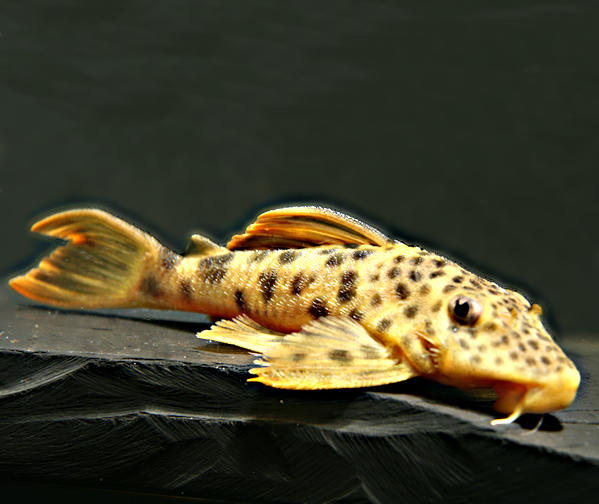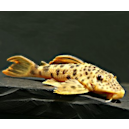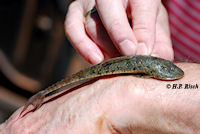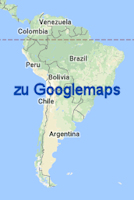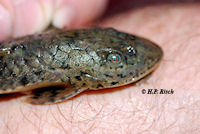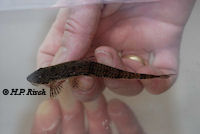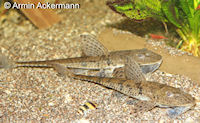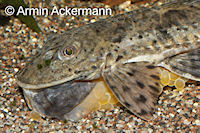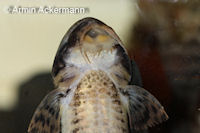platus (gr.) - breit, metopo (gr.) - Stirn
Synonyme
rapa-canoa
Viola-de-cara-redonda
Viola-de-cara-redonda
nicht gefährdet (Least Concern)
Länge (total)
etwa 33 cm
Standardlänge (dokumentiert)
299,0 mm
Empfohlene Aquariengröße
180 cm
Temperatur
26 - 30 °C
➀ lago Ypacarai bei San Bernardino, río Alegre, río Aquidaban = río Aquido Canigi, rio Branco = río Cabixi, río Colastiné, río Confuso, río Coronda, río Jaurú, río Salado, ➀ rio Taquari = ribeirão Taquari, ➀ río Tebicuary, arroyo Tobati, ➀ lago Janauaca, ➀ río Guaporé = río Iténez -, ➀ río Paraguay = rio Paraguai -, unterer ➀ río Paraná = rio Paraná -, unterer / mittlerer ➀ río Uruguay = rio Uruguai-Einzug
Chaco, Santa Fé, Rio Grande do Sul, Paraná, Mato Grosso, Mato Grosso do Sul, Central, Concepción, Presidente Hayes, Canendiyu, Paraguary, San Pedro
Argentinien, Brasilien, Paraguay, Uruguay, Venezuela
río Guaporé → río Mamoré → rio Madeira → Amazonas → Atlantic NE ↓ río Piribebuy ➙ río Yhaguy ➙ río Manduvira | rio Taquari | río Salado ⇒ rio Paraguai = río Paraguay → río Paraná → río de la Plata → Atlantic SE
[ -25.283,-57.320 ]
Substrat
Schlamm/Schlick
Ernährung (überwiegend): Allesfresser (omnivore)
Detritus, Wirbellose (aquatisch) (invertebrates (aquatic)), (Sand, Sedimente), Algen, Amöben, Wirbellose (invertebrates ), Wirbellose (terrestrisch) (invertebrates (terrestris)), Kieselalgen (Bacillariophyceae), Ruderfußkrebse (Copepoda), Muschelkrebse (Ostracoden), pflanzliche Fasern, Zweiflügler (Diptera), Insekten
Frisst Pflanzen
nicht bekannt
Die Haltung in (kleinen) Gruppen ist zu empfehlen. Einzelhaltung ist möglich.
Kann atmosphärisch atmen
ja
von der Gattung: Lippen beachten
Lippenbrüter
ja
WA 1
Auf der Positivliste von Brasilien 2012 : Die Positivliste Brasiliens
Nicht auf der Negativliste Brasilien von 2020 : Die Negativliste von Brasilien
Nicht auf der Negativliste Brasilien von 2020 : Die Negativliste von Brasilien
- Reis, R.E., Kullander, S.O. & Ferraris, C.J. et.al., 2003 "Check List of the Freshwater Fishes of South and Central America" S. 339
- Seidel, Ingo: "Lippenbrüter in ihren natürlichen Lebensräumen"
(Aquaristik Fachmagazin Aug./Sep. 2015)
- Isbrücker, I.J.H. & Nijssen, H., 1979 "Three new South American mailed catfishes of the genera Rineloricaria and Loricariichthys (Pisces, Siluriformes, Loricariidae)" (Bijdragen tot de Dierkunde, Vol. 48 No. 2, S. 191)
- Ota, R.R.; Carvalho Deprá, G. de; Graça, W.J. da & Pavanelli, C.S., 2018 "Peixes da planície de inundação do alto rio Paraná e áreas adjacentes: revised, annotated and updated" (Neotropical Ichthyology, Vol. 16 No. 2, S. 77)
- Londoño-Burbano, A. & Reis, R.E., 2021 "A combined molecular and morphological phylogeny of the Loricariinae (Siluriformes: Loricariidae), with emphasis on the Harttiini and Farlowellini" (PlosOne)
- Gimênes Junior, H. & Rech, R. , 2022 "Guia ilustrado dos peixes do Pantanal e entorno"
- Silva, G.H.; Zeni, J.O. & Langeani, F., 2025 "Head morphology and diet of whiptail catfishes (Loricariidae: Loricariinae)" (Neotropical ichthyology, Vol. 21 No. 3)
- Malabarba, L.R.;Hirschmann,A.; Lucena,C.A.S. de; Giora,J.; Wingert,J.M.; Ferrer,J.; Silva,P.C ; Angrizani,R.C.; Costa Ramos,R. da; Kullander,S.; Carvalho,T.P.; Bertaco,V.; Fialho,C.B. & Bonato,K.O., 2025 "Guia Peixes do Bioma Pampa"
- --- finde mehr ---
